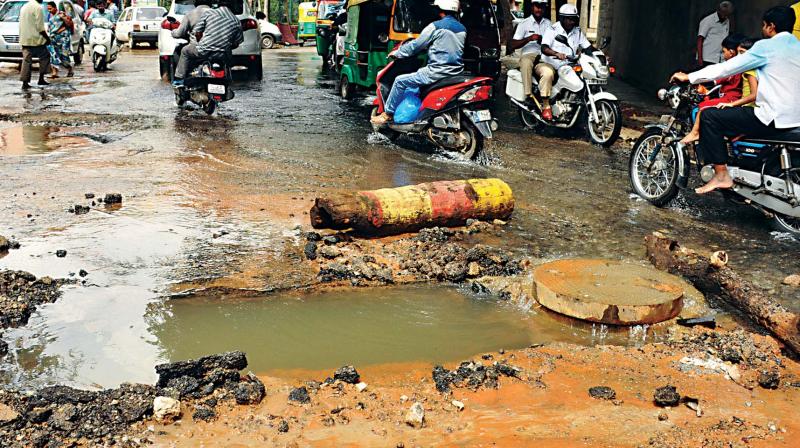Fix manholes, BWSSB, our Bengaluru’s going down the drain
This is much worse during the monsoon, posing a serious hygiene threat, especially when restaurants and eateries are located in its vicinity.

Overflowing manholes are one of Bengaluru's biggest problems, often leaving the roads flooded and filled with garbage and the stench from the drains. This is much worse during the monsoon, posing a serious hygiene threat, especially when restaurants and eateries are located in its vicinity. Complaints to BWSSB have been in vain, say angry residents. Regular desilting of storm water drains and construction of sewage treatment plants to treat dirty water are the real solutions, reports Aknisree Karthik
It is located right in the middle of the road in Chalwadipalya next to the MS Marriage Hall and vehicles regularly pass over it as they drive down it. While most days the manhole is innocuous, come rain and it becomes a hell-hole, overflowing and spewing its contents on the road, raising a stink and spreading harmful bacteria into the surroundings.
Although cars and two- wheelers manage to drive through without suffering too much, pedestrians have it hard, with some even stepping on the excreta thrown out from it. People like Mr Shivakumar, a local resident, have little choice but to suffer this nightmare every monsoon as the authorities have done little to find a permanent solution to the manhole problem.
With the recent rain once again causing it to overflow, Mr Shivakumar complains bitterly, “Food is prepared in the open in the small cafeteria around this overflowing manhole. There is a biryani selling hotel, a chats corner, a tea shop and bakery. The food is bound to get contaminated with harmful bacteria from the manhole.”
The people of the area have given up complaining to the BWSSB as the problem arises in every spell of rain, leaving them disgusted , but resigned. “People have become used to this and are just living with this hell,” Mr Shivakumar laments.
The problem is not confined to this area alone, but is common to many parts of the old city like Cottonpet and Akkipet, where old rusted sanitary lines have still not been fully replaced. “The sanitary lines are old and don’t have the carrying capacity as the population has grown, ” notes Ms Sumalatha, a resident of Cottonpet.
Besides, not much effort is made to clean the manholes regularly, say the people of the crowded, dirty bylanes of the area, who have become accustomed to living with the garbage and the stench from the drains that are another source of distress.
BWSSB unmoved by the problem: Gangambike Mallikarjun
It’s not just the people who are upset with the BWSSB for manholes continuing to overflow in rain in many parts of the city, but also mayor Gangambike Mallikarjun. Ask her about the problem and she says it's common even in her own Jayanagar ward and although she is in regular touch with the BWSSB to deal with it, little is accomplished. “They promise to take action on the complaints about manholes overflowing, but there is little change on the ground,” she observes. The fact that the mayor herself is not able to put a stop to the problem in her own ward speaks volumes about how poorly the manholes are managed and how unmoved the BWSSB is by the health hazard they present. In Ms Mallikarjun's view, the only solution is to clean the manholes regularly and also replace the old sanitary lines with pipes of greater carrying capacity to cater to Bengaluru's rising population.
Ask a BWSSB official about what the board intends to do about the manholes and he admits that there is no system in place to regularly clean them all over the city to stop them from overflowing in rain. "Only when the call centre receives a complaint about a manhole being blocked do we send our jetting machines to clean it. In some areas where such complaints are received more often, we use jetting and sucking machines to unclog the manholes more regularly,” he explains.
However, the only assurance he gives is that more of the city’s sewage will be treated in future as more Sewage Treatment Plants are in the pipeline. “At present the city has 24 STPs and we are planning to build more of them. Also we are gradually working on preventing people from directly letting their sewage into stormwater drains by building sewage lines,” he says, a promise that does nothing, however, to help people fighting a losing battle with the overflowing manholes in their midst.

